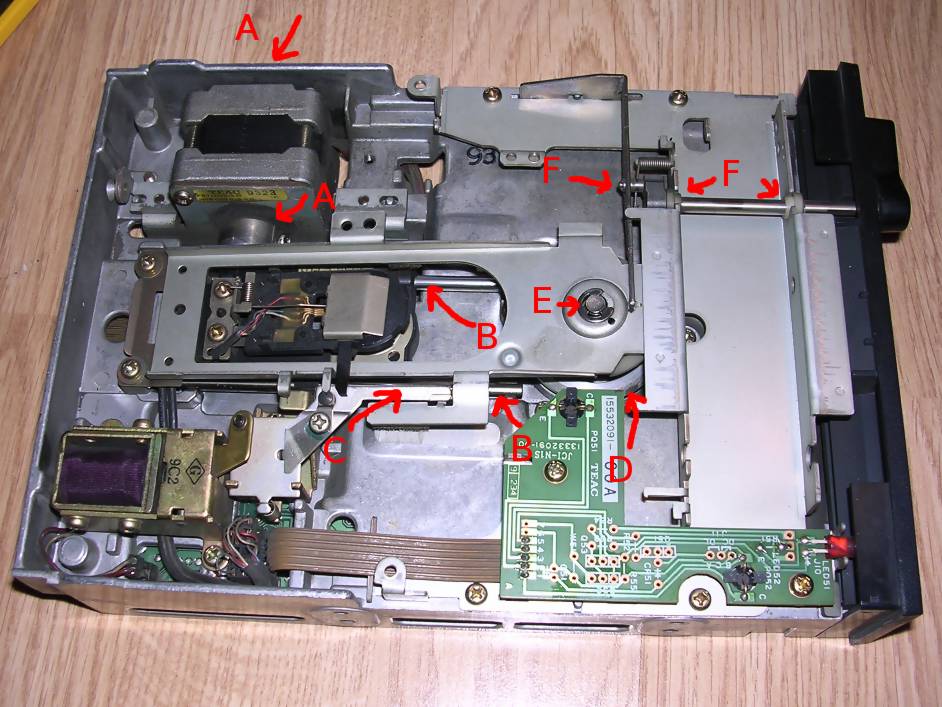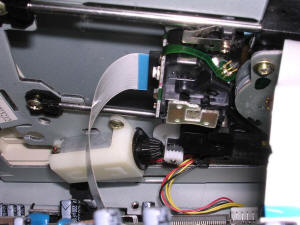Chapter 11: Floppy disk drives
The first and most important thing:
Do not stick a working disk to uncertain drive. Review the drive before.
In many cases you will find seriously damaged 3.5 and 5.25" drives. Some of them
can be repaired. Many not.
Let's look at typical drive's parts:
If the drive has a belt mechanism, check its condition. Does the belt move
without spinning motor's hub or spindle? Maybe it needs to be replaced. Check
does the motor's hub spin easily - sometimes a drop of grease may be needed to
motor's bearings.
The exception there is a belt-driven Siemens 3.5" notebook drive. If motor fails
in it, it will never get stable rotary speed back.
If there is an integrated on-board motor, you don't have much field to move.
Check does it spin and does the disk hub rotate smoothly.
To apply a drop of lubricating oil into bearing (use REALLY SMALL amount of it),
use a syringe with needle. While filling, oil goes slowly inside and while
applying it goes slowly too. Needle allows to reach difficult areas near
rotating shafts or bearings.
There is one more problem with spindle motors in 5.25" drives: Sometimes,
especially in cheaper drives, the upper part which presses the disk to hub may
be out of center. Then after extensive use part of it wears off faster, so it
locks in the metal hub. Even if you polish it to become uniform, it may still
lock or loose pressing force which keeps the disk in place.
Head stepper motor
There are many designs of stepper motor driving head carrier. In 5.25" drives
the most popular is using metal belt which rolls off the motor's hub and pushes
the head carrier. This is quite rigid design and the only thing causing problems
there is bad motor or jammed carrier. Other designs include flat disk with
spiral engraving (in which typical problem is dust covering this engraving), or
screw mechanism (popular in 3.5" drives).
Screw mechanism needs lubrication. If there is no lubrication on a screw, add
some, but not too much.
Usually you will be able to move the head carrier by rotating the motor's hub.
The only exception is in 3.5" drives with screw mechanism, in which forces are
quite big relative to size of the screw. If carrier gets stuck, it means that
there is a problem with carrier track rods or mechanism. Clean everything from
dust and apply a bit of lubricant on shiny carrier track rods.
Solenoid is a mistake.
If the drive has a solenoid for dropping heads on the disk, you should know that
this drive won't last for too long. The solenoid introduces relatively high
vibrations right into heads assembly, slowly knocking them out of alignment. It
is possible to re-callibrate heads, but it is a slow and painful procedure.
Avoid such drives.
Here we end with mechanical part. Below you can see a typical
5.25" drive (with a solenoid, the purple thing in lower-left part) with
important parts marked. Not all drives look this way, most have no solenoid.

OK, let's begin:
A - Stepper motor shaft - may require cleaning/lubrication if
motor doesn't move well.
B - Two silver head carrier rails - may require cleaning and
lubrication if head carrier stucks.
C - Head carrier topmost rail for pull-down (solenoid or
lock-based) mechanism. Requires cleaning, rarely lubrication
D - The bearing under the bottom hub - in older drives may
require cleaning and lubrication, do it using a syringe with needle to reach it.
E - Top part of hub - requires cleaning, sometimes with
penetrating-lubricating solution like WD40.
F - Lock bearings - require cleaning.
Optical part
Optical part in many drives is quite rigid. Usually blowing with air and using
brush is enough, sometimes it may be needed to use a cloth with some cleaning
liquid which doesn't leave residues. In typical drive you may find the following
optical barriers:
- Detection of outwards track of the disk - near the head carrier
- Detection of inside track of a disk - sometimes present, sometimes not, near
the head carrier
- Index hole detector (5.25" drives only) - in the center, near hub
- Write protect tab detector (in 5.25" drives) - it sometimes serves as "disk
change" detector as disk during insertion crosses its ray.
- Format detector - in some rare 3.5" drives, format hole detector and write
protect tab detector are made with optical barriers, not mechanical switches.
Heads
Now it's time to clean heads. Do it at the end when no other dust will fly
inside the drive. I'm using a piece of cloth with window cleaning fluid. The
cloth is placed around a flat piece of metal which allows to reach heads. Do not
damage the alignment of heads in this step! Some drives may have oxide layers or
even water residues on heads, so clean them properly.
Some single-sided drives with head on the bottom allow to open upper part of
head assembly to clean head.
Heads alignment
The symptom of unaligned heads is simple: The drive fails to read the end of the
disk, first tracks may be read OK, and the same drive reads perfectly disks
formatted by itself. To fix it, you have to open the drive to have access to
heads, while drive is still connected to computer. You need also a disk
formatted on another, correct drive, filled to the last byte with some data.
So in MS-DOS, for example, try to read it, e.g. copy files from the disk to hard
drive.
"Sector not found?" huh?
Without removing disk loose upper head's locking screw (usually protected by
paint) and move the head a little. Fasten the screw a bit. Retry.
And again, and again... Usually "General fialures" mean that system has given up
and you need to restart the procedure from rebooting the computer. Alignment
made this way takes from few hours to few days. The proper procedure used in
repair workshops requires oscilloscope and special alignment disk which cannot
be made in a normal PC.
In some floppy, "floptical", magneto-optical or CD drives, a gear
rack mechanism is used instead of belt one. In the picture on the right
you can see such mechanism in old 32X CD drive. The motor drives the
gear by conical transmission, the gear pushes or pulls the rack which is
connected to the laser. These mechanisms work well for yaers even
without lubrication, but it is important to check do such meahcnism move
at all.
The common problems are linear bearings and driving shafts, they
sometimes need lubrication.If any mechanical drive was subjected to
atmospheric conditions (read: water, humidity, rain) end switches should
be checked with "beeper" tester and if they fail they should be cleaned
with alcohol (small end switches only need spraying it inside). In such
cases all connections should be re-seated and all optical barriers well
cleaned. Window cleaning fluid with alcohol is usually sufficient to
remove results of atmospheric exposure from these components. Be sure to
dry them well before testing. |
 |
MCbx, 2016



